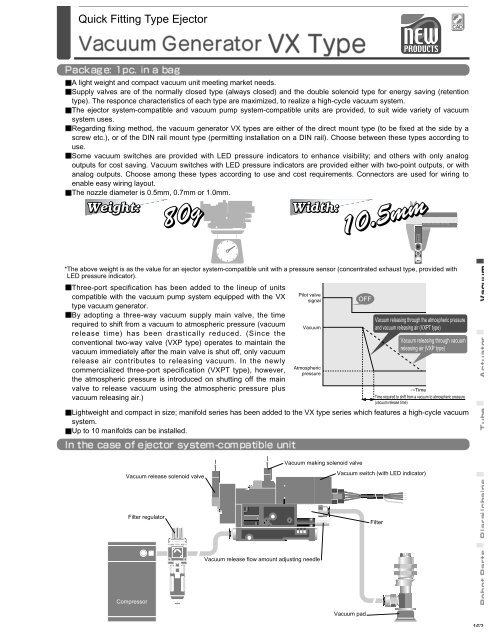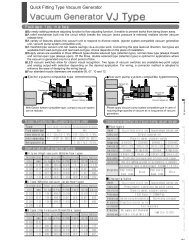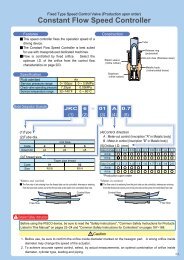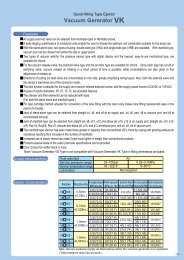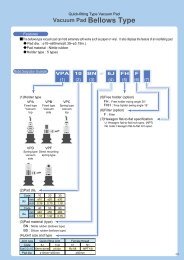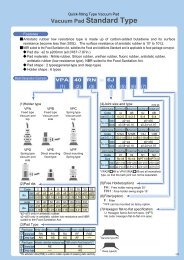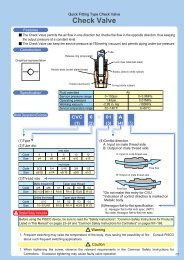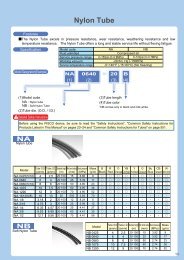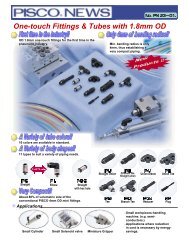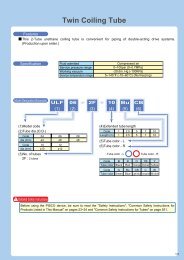Quick Fitting Type Ejector - Pisco Pneumatic Equipment
Quick Fitting Type Ejector - Pisco Pneumatic Equipment
Quick Fitting Type Ejector - Pisco Pneumatic Equipment
You also want an ePaper? Increase the reach of your titles
YUMPU automatically turns print PDFs into web optimized ePapers that Google loves.
<strong>Quick</strong> <strong>Fitting</strong> <strong>Type</strong> <strong>Ejector</strong>CADA light weight and compact vacuum unit meeting market needs.Supply valves are of the normally closed type (always closed) and the double solenoid type for energy saving (retentiontype). The responce characteristics of each type are maximized, to realize a high-cycle vacuum system.The ejector system-compatible and vacuum pump system-compatible units are provided, to suit wide variety of vacuumsystem uses.Regarding fixing method, the vacuum generator VX types are either of the direct mount type (to be fixed at the side by ascrew etc.), or of the DIN rail mount type (permitting installation on a DIN rail). Choose between these types according touse.Some vacuum switches are provided with LED pressure indicators to enhance visibility; and others with only analogoutputs for cost saving. Vacuum switches with LED pressure indicators are provided either with two-point outputs, or withanalog outputs. Choose among these types according to use and cost requirements. Connectors are used for wiring toenable easy wiring layout.The nozzle diameter is 0.5mm, 0.7mm or 1.0mm.*The above weight is as the value for an ejector system-compatible unit with a pressure sensor (concentrated exhaust type, provided withLED pressure indicator).;;Three-port specification has been added to the lineup of unitscompatible with the vacuum pump system equipped with the VXtype vacuum generator.By adopting a three-way vacuum supply main valve, the timerequired to shift from a vacuum to atmospheric pressure (vacuumrelease time) has been drastically reduced. (Since theconventional two-way valve (VXP type) operates to maintain thevacuum immediately after the main valve is shut off, only vacuumrelease air contributes to releasing vacuum. In the newlycommercialized three-port specification (VXPT type), however,the atmospheric pressure is introduced on shutting off the mainvalve to release vacuum using the atmospheric pressure plusvacuum releasing air.)Pilot valvesignalLightweight and compact in size; manifold series has been added to the VX type series which features a high-cycle vacuumsystem.Up to 10 manifolds can be installed.VacuumAtmosphericpressureOFFVacuum releasing through the atmospheric pressureand vacuum releasing air (VXPT type)Vacuum releasing through vacuumreleasing air (VXP type)TimeTime required to shift from a vacuum to atmospheric pressure(vacuum release time)Vacuum making solenoid valveVacuum release solenoid valveVacuum switch (with LED indicator)Filter regulatorFilterVacuum release flow amount adjusting needleCompressorVacuum pad162
Vacuum release solenoid valveVacuum making solenoid valveVacuum switch (with LED indicator)FilterVacuum release flow amount adjusting needleVacuum pumpPilot air supplyVacuum pad* "Responce time" is the time elapsed before detecting pressure change at the vacuumport, under the rated pressure and at the rated voltage. Time required formaking/releasing a vacuum at the pipe tip (work) varies according to ejectorcharacteristics, pipe volume (length), flow rate for vacuum release etc.* The response time is the time elapsed, at a supply pressure of 0.5MPa and the ratedsupply voltage, before a change in pressure is detected at the vacuum port. The timerequired to reach vacuum and the time required to release the vacuum, both measuredat the end of the piping (at the workpiece), depend on factors such as the volume(piping length) and vacuum release air flow.163
*1.Value for a supply pressure of 0.5MPa.*2.Note that in the case of double solenoid type, it is impossible to meet specifications onvalve response if the flow rate is outside the above range.*3.The vacuum release air flow depends on factors such as the diameter and length ofthe vacuum side piping (piping resistence).*1.Value for a supply pressure of 0.5MPa.*2.The vacuum release air flow depends on factors such as the diameter and length ofthe vacuum side piping (piping resistence).*1. Open to air/concentrated exhaust*2. These specifications are different from those of the conventional PISCO vacuumseries.Before using the PISCO device, be sure to read the "SafetyInstructions", "Common Safety Instructions for Products Listed inThis Manual" on page 15 to 17 and "Common Safety Instructions forVacuum" on page 137 to 138.1. For the operation of the valve, make certain that the leakage current is lessthan 1mA. Leakage current larger than that may cause malfunction.2. Vacuum pump system-compatible unit, two-port specification (VXP type),with vacuum hold function permits vacuum leakage; therefore, provide anappropriate safe means whereby vacuum may be held for a long time. Notethat the three-port unit (VXPT type) has no vacuum hold function.3. Long continuous power supply to the pilot valve may raise the temperatureof the coil. Heat may cause burns or affect the surrounding equipmentadversely. Consult PISCO about such applications.4. A model with retention type air supply valve (refer to as double solenoidtype), VX D- , must confirm position of change valve by sending signalto or by manually operation of pilot solenoid valve when re-supplying pilot airafter shut down once or initial setting because the change valve is placed atneutral position.5. If the unit may be vibrated or shocked when using the DIN rail type, fix it onboth sides using commercially available DIN rail fittings to ensure security.6. Before attaching the unit to or detaching it from the manifold, shut off the airsupply and evacuate the remaining pressure completely.7. After mounting the unit on the manifold, insert the lock lever as far as it willgo and secure it with a screw. Vibration may cause the lock lever todisengage; this may cause the unit to jump out.1. In order to avoid disconnection and/or damage to the connectors, do notallow the pilot valve and vacuum switch lead wires to be pulled or bent.2. Compressed air contains a variety of foreign matter (such as water, oxidizedoils, and mineral tar among others). Since foreign matter substantiallyreduces the performance of the unit, air quality should be enhanced bydehumidification via after-coolers or dryers.3. Do not use this equipment mear corrosive and/or flammable.4. Rust on piping may cause malfunction. Accordingly, install a filter (length:5µm or shorter) in the portion directly leading to the supply port. It isadvisable to flush the pipe interior before use, and subsequently atappropriate intervals.5. Do not use this equipment near corrosive and/or flammable gases. Do notuse this equipment for the handling of fluids.6. When replacing the cartridge joint of the supply (PS, PV) port, remove anyforeign matter attached to the seal, and insert the fixing pin correctly.7. When replacing the cartridge joint of the vacuum (V) port, make sure thatthe wind packing has not been detached. Then, remove any foreign matterattached to the seal, and fix the screw correctly at the specified torque.8. Before mounting the unit on the manifold, always make sure that the O-ringson the air supply (vacuum supply) port and exhaust (air supply) port are notmissing or pushed off.164
High-vacuum Middle-flow typeMiddle-vacuum Large-flow typeHigh-vacuum Small-flow type*For L (middle-vacuum large-flow) type (nozzle diameter: 1.0mm), no setting is providedfor the concentrated exhaust type.*1. The supply pressure for H and L types is 0.5MPa; and that for E type is 0.35MPa.*2. The suction flow rates shown in parentheses are those for the concentrated exhausttype.Normally closed typeDouble solenoid type (retention type)*The air supply port size is the same as that specified for the vacuum port size.Vacuum pump system-compatible unit, two-port specificationVacuum pump system-compatible unit, three-port specification*For the vacuum pump system-compatible unit, no setting is provided for the double solenoid type of specifications for solenoid valves.165
High-vacuum Middle-flow typeMiddle-vacuum Large-flow typeHigh-vacuum Small-flow type*1. The supply pressure for H and L types is 0.5MPa; and that for E type is 0.35MPa.*2. The suction flow rates shown in parentheses are those for the concentrated exhausttype.Normally closed typeDouble solenoid type (retention type)Vacuum pump system-compatible unit, two-port specificationVacuum pump system-compatible unit, three-port specification*The double solenoid type is not available for vacuum pump system-compatible units as for the single unit type.167
Unit modelVacuum characteristic Nozzle diameterValve typeVacuum port (V) Air supply port (PS) Exhaust port (EX)Solenoid valve typeSpecifications for vacuum switchesNo. of manifoldUnit modelKUnit designation00K0Vacuum port (V)8Air supply port (PS)SVacuum supply port (PV)D24Solenoid valve typeKSpecifications for vacuum switches04No. of manifoldL sideStation No.R sideSt.1St.2St.3St.4St.5St.6St.7St.8St.9St.10EEHH07070505DD6644DWDWL sideVacuum port (V);Air supply port (PS)St.1St.2St.3St.4Exhaust port (EX)R side*The stations are numbered St.1, St.2, St.3side with the vacuum port to one side.St.10 beginning on the L (left)Unit modelVacuum characteristic Nozzle diameterValve typeVacuum port (V) Air supply port (PS) Exhaust port (EX)Solenoid valve typeSpecifications for vacuum switchesNo. of manifoldUnit modelUnit designationVacuum port (V) Air supply port (PS) Exhaust port (EX)Solenoid valve typeSpecifications for vacuum switchesNo. of manifoldL sideStation No.R sideSt.1St.2St.3St.4St.5St.6St.7St.8St.9St.10KTTTTTT04444446611D24KAOAOAOAOAOAODADA08L sideVacuum port (V);;St.1St.2St.3St.4St.5St.6St.7 St.8Vacuum supply port (PV)Pilot air supply port (PS)R side*The stations are numbered St.1, St.2, St.3side with the vacuum port to one side.St.10 beginning on the L (left)168
To: PISCOFrom:Signature:Name (Print):Order No:Date:Desiring Delivery Date: Quantity: unitsUnit modelVacuum characteristic Nozzle diameterValve typeVacuum port (V) Air supply port (PS) Exhaust port (EX)Solenoid valve typeSpecifications for vacuum switchesNo. of manifoldUnit modelUnit designationVacuum port (V) Air supply port (PS) Exhaust port (EX)Solenoid valve typeSpecifications for vacuum switchesNo. of manifoldL sideStation No.R sideSt.1St.2St.3St.4St.5St.6St.7St.8St.9St.10*1. Refer to the Model Designation examples provided in the foregoing to make entries into the specification order form (P.158).*2. Make photocopies of this page.*3. Use a different form as required if specifications differ.169
ModelModelModelVX (D)- S-VX (D)- S- -DVX (D)- J-ModelVX (D)- S- -DWModelVX (D)- S- -DW-DModelVX (D)- J- -DWModelVX (D)- S- -DAModelVX (D)- S- -DA-DModelVX (D)- J- -DAModelVX (D)- S- -A0ModelVX (D)- S- -A0-DModelVX (D)- J- -A0170
ModelModelModelVX (D)- J- -DVXP- -VXP- - -DModelModelModelVX (D)- J- -DW-DVXP- - -DWVXP- - -DW-DModelModelModelVX (D)- J- -DA-DVXP- - -DAVXP- - -DA-DModelModelModelVX (D)- J- -A0-DVXP- - -A0VXP- - -A0-D171
;;Filter element(Model: VXV010B30);;VXPT- -ModelVXPT- - -DModelVXV010B30Model Designation;Silencer element(Model: VXV010B29);;Silencer element(Model: VXV010B28);Model DesignationVXPT- - -DWModelModelVXPT- - -DW-DVXV010B28VXV010B29VXPT- - -DAModelVXPT- - -DA-DModel;; ; Silencer element(Model: VXV010B29)Silencer element(Model: VXV010B28);;; Model DesignationVXV010B28VXV010B29VXPT- - -A0ModelVXPT- - -A0-DModelValve filter;element(Model: VXV010B72)VXV010B72Model Designation172
ModelModelModelVX - - -MVXP- - -MVXPT- - -MModelVX - - -DW-MVXP- - -DW-MModelModelVXPT- - -DW-MModelVX - - -DA-MVXP- - -DA-MModelVXPT- - -DA-MModelModelVX - - -A0-MVXP- - -A0-MModelVXPT- - -A0-MModel173
Tapping screw;Silencer elementSilencer cover(Model: VXV010B92)VXM-VXM-VXM-VXM-VXM-VXM-VXM-VXM-VXM-Model-02 (twofold)-03 (threefold)-04 (fourfold)-05 (fivefold)-06 (sixfold)-07 (sevenfold)-08 (eightfold)-09 (ninefold)-10 (tenfold)VXV010B92Model Designation174


